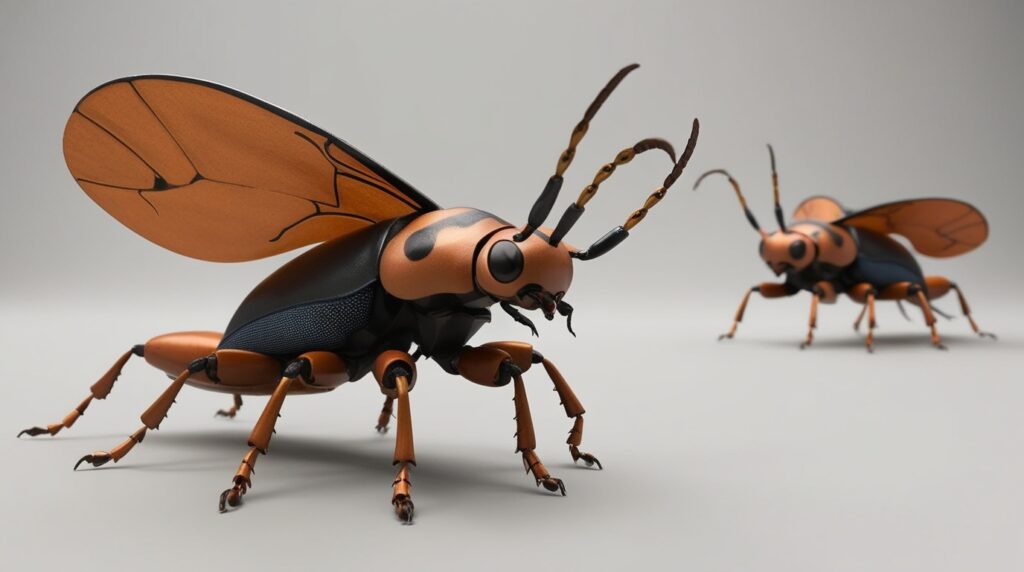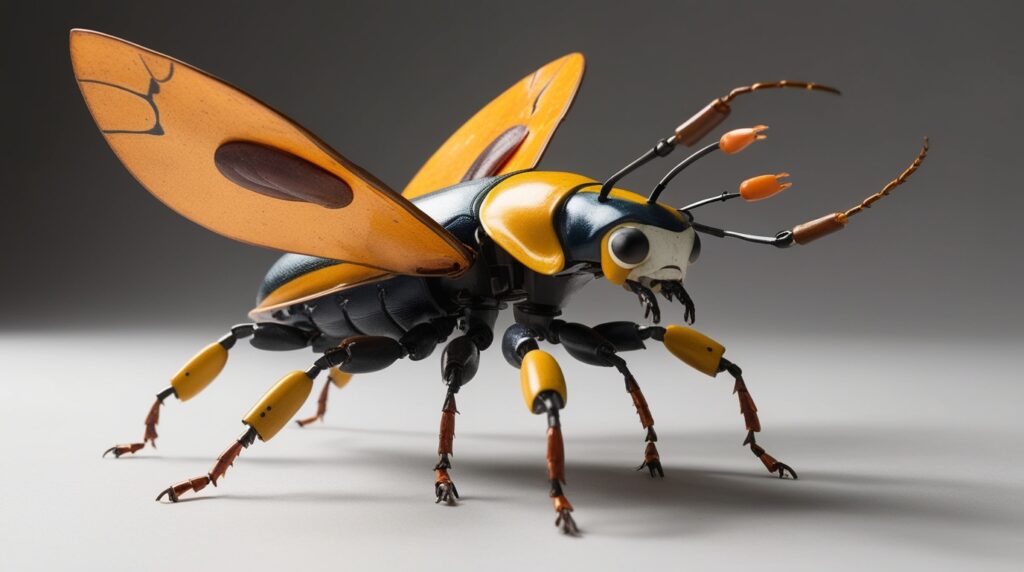
Introduction
Beetle Inspired Flapping Robots are a burgeoning field of robotics that draws inspiration from the diverse adaptations found in the Coleoptera order of insects, particularly beetles, which comprise about 400,000 species. Researchers aim to replicate the unique mechanisms of beetle flight and locomotion to develop miniature, agile robots capable of performing complex tasks in environments challenging for conventional technology.
The study of these robots combines principles from biology, materials science, and engineering, making it a notable area of interdisciplinary research with significant implications for various applications, including search and rescue, environmental monitoring, and precision agriculture. The design and functionality of beetle-inspired robots utilize bioinspired mechanisms that mimic the jumping and flying capabilities of beetles, employing innovations such as deformable bodies and morphing wings. Recent advancements include the integration of intelligent wings that utilize piezoelectric materials for self-contained flight control, enhancing the robots’ operational autonomy and efficiency.
This design approach not only enhances maneuverability but also allows for the exploration of applications in settings where traditional robots struggle, such as navigating debris in disaster scenarios or monitoring environmental conditions in remote areas. Despite their promise, the development of beetle-inspired flapping robots is not without challenges. Issues related to energy consumption, resilience to environmental factors, and the complexities of accurately mimicking biological mechanisms present significant hurdles for researchers.
Addressing these challenges is crucial for optimizing the robots’ performance and ensuring their reliability in practical applications. Future research will likely focus on enhancing manufacturing consistency, improving energy efficiency, and exploring further insect models to inform design innovations.
As this field progresses, beetle-inspired flapping robots stand to revolutionize our approach to robotics by providing insights into efficient design strategies rooted in nature, ultimately aiming to create fully autonomous, insect-scale vehicles capable of navigating and performing tasks in diverse environments.
History of Beetle Inspired Flapping Robots
The study of beetle-inspired flapping robots began as researchers sought to explore the remarkable adaptations found in the Coleoptera order, which comprises approximately 400,000 species. This interest stems from the desire to understand how insects manage challenges of miniaturization, which can inform advancements in robotics, materials science, and nanotechnology. Early efforts in this domain utilized a trial-and-error approach akin to natural selection to develop initial prototypes.
Researchers from the University of Illinois and Princeton University produced hundreds of different designs using 3D printing, progressively refining these designs based on performance metrics. As the field evolved, mathematical models were developed to further optimize the designs of these miniature robots, including the integration of sensory components such as light sensors and microcontrollers, allowing the robots to respond dynamically to their environment.
Significant progress was marked by advancements in the development of intelligent wings, which utilize piezoelectric materials to enable self-contained flight control. This innovation has profound implications for a range of applications, including robotic environmental sampling and search-and-rescue operations, particularly in environments where conventional technology may struggle. As research continues, the pursuit of creating fully autonomous, agile, insect-scale aircraft remains a critical focus, with bioinspired designs providing a promising avenue for future exploration.
Design and Functionality of Beetle Inspired Flapping Robots
Bioinspired Mechanisms
Beetle-inspired flapping robots draw heavily from the unique mechanisms found in natural beetles, particularly their jumping and flying capabilities. One notable example is a miniature robot that mimics the click beetle’s mechanism by utilizing a deformable body containing a stainless-steel beam attached to an artificial muscle made of nylon fibers. When the muscle contracts, the beam buckles and stores elastic energy, allowing the robot to achieve a powerful jump upon release. This design approach not only enhances the robot’s agility but also its ability to navigate complex terrains, making it applicable in fields like precision agriculture and machinery maintenance.
Structural Innovations
The wings of beetles offer insights into creating advanced mechanical designs. For instance, the unique folding and unfolding mechanisms of beetle hind wings have inspired the development of morphing wings for micro air vehicles (MAVs). By utilizing shape memory alloys, artificial wings can be actuated to unfold and provide necessary thrust during flight, thus informing the design of biomimetic deployable systems. These advancements highlight the potential for creating lightweight composite structures that replicate the intricate features of beetle elytra, such as honeycomb cores and trabecular designs, through innovative manufacturing processes.
Multifunctionality and Energy Efficiency
Recent research has demonstrated the utility of beetle wings in developing energy-efficient robotic systems. A bioinspired design using a flapping-wing structure allows for the harvesting of energy during flight, which can power onboard sensors for mobile environmental monitoring. This capability enhances the robot’s functionality while reducing the need for external power sources, thus increasing its autonomy and operational range.
Experimental Approaches
To optimize these designs, researchers employ methodologies akin to natural selection. For instance, teams at the University of Illinois and Princeton University created hundreds of prototypes using 3D printing, iteratively refining the best-performing designs. This trial-and-error approach enables engineers to capture the essence of biological mechanisms effectively while utilizing advanced modeling techniques to further enhance performance and functionality.
Aerodynamics
The study of aerodynamics in beetle inspired flapping robots focuses on understanding the unique flight mechanisms found in nature to improve the design and performance of micro air vehicles (MAVs). Beetles exhibit specialized wing structures and folding mechanisms that influence their aerodynamic efficiency and maneuverability, which can be emulated in robotic designs.
Wing Mechanics
Beetle wings, particularly the hind wings, employ a combination of folding and unfolding mechanisms that are crucial for flight dynamics. These wings are composed of several plates connected by hinges, which allow for a single kinematic degree of freedom during flapping. The contraction of muscles attached to the basalar sclerite facilitates wing extension, while the active flexion lines contribute to altering the wing profile during flight. Understanding these mechanisms can inspire the development of morphing wings in MAVs, enhancing adaptability and performance.
Aerodynamic Models
The aerodynamic modeling of insect-like flapping flight is vital for designing efficient MAVs. Various approaches to modeling, such as steady-state, quasi-steady, semi-empirical, and fully unsteady methods, have been explored. Notably, the unsteady aerodynamic model developed by Ansari et al. is considered particularly effective, offering insights into lift and propulsion mechanisms during flapping flight. These models enable researchers to iterate through various design configurations rapidly, optimizing the aerodynamic characteristics of flapping wing vehicles (FWVs) and enhancing their flight capabilities.
Efficiency and Performance
Research indicates that the phasing of dragonfly wings can improve aerodynamic efficiency by minimizing swirl, thereby increasing lift and reducing power consumption during flight. The dynamics of wing-wake interactions further influence the production of aerodynamic forces, which are essential for effective hovering and maneuvering. Studies on wing flexibility have shown that it can reduce energetic requirements, making flapping flight more efficient, which is critical for the design of energy-conserving robotic systems.
Applications of Beetle Inspired Flapping Robots
Beetle inspired flapping robots have a variety of applications across different fields, leveraging their unique design features and capabilities.
Search and Rescue Operations
One of the most promising applications of these robots is in search and rescue missions. Their small size and ability to navigate through confined spaces make them ideal for entering collapsed structures where human access is limited. For example, a microrobot designed with foldable wings can fly into narrow openings and, when necessary, switch to crawling mode to maneuver through debris. This adaptability allows for efficient search operations in hazardous environments where traditional rescue methods might fail.
Environmental Monitoring
Beetle-inspired robots are also being explored for environmental monitoring tasks. Their design enables them to collect data in various terrains, including urban areas and natural landscapes. Some models are equipped with sensors that can monitor atmospheric conditions, aiding in tasks like assessing air quality or tracking changes in humidity levels. This capability is particularly useful in developing autonomous UAV-based monitoring systems, which can provide real-time data for environmental assessment.
Biomechanics and Robotics Research
In the field of robotics research, these flapping robots serve as a platform for studying biomechanics and aerodynamics. Researchers are able to simulate and analyze the flapping mechanisms of beetle wings to improve designs for both aerial and terrestrial robots. The insights gained from this research can lead to advancements in robotics technologies, including the development of more efficient and maneuverable vehicles.
Educational and Demonstrative Tools
Finally, beetle inspired flapping robots are increasingly being used as educational tools. They offer hands-on experiences for students and researchers interested in robotics, engineering, and biological systems. By mimicking natural designs, these robots provide a practical application of biomimicry principles, illustrating how biological insights can inform technological innovations.

Case Studies of Beetle Inspired Flapping Robots
Rhinoceros Beetle-Inspired Micromachines
Researchers have drawn inspiration from the rhinoceros beetle to develop advanced flying micromachines. By employing slow-motion cameras to study the beetle’s flight mechanics, an international team designed a micromachine that mimics its wing movements. This robot features retractable wings that expand for takeoff, allowing it to hover and flap while airborne, and retract upon landing to protect against potential impacts. The resilience of this design is crucial for navigating hazardous environments, such as areas affected by natural disasters.
Click Beetle Jumping Mechanism
In another innovative approach, engineers at the University of Oxford have modeled a robot based on the click beetle’s jumping mechanism. This robot utilizes a deformable body containing a stainless-steel beam connected to an artificial muscle made from nylon fibers. When the artificial muscle contracts, the beam stores elastic energy through a snap-buckling mechanism, which is released to propel the robot into high jumps. Notably, the robot achieves an acceleration of 250G during jumps, vastly exceeding the forces experienced by astronauts during space launches.
Microcassette Tape-Sized Robots
Researchers in Chen’s lab are developing tiny robots comparable in size to microcassette tapes, with wings powered by dielectric elastomer actuators (DEAs). These soft artificial muscles allow rapid wing flapping through mechanical forces, enhancing the robot’s ability to maneuver through complex environments. This design aims to improve the resilience and agility of small robots, crucial for tasks like precision agriculture and maintenance of large machinery.
Future Research Directions in Beetle Inspired Flapping Robots
Building on these findings, researchers aim to establish a comprehensive physics-based model that integrates the biomechanics of insect flight with their neural circuitry. Future studies will involve collecting data from various flying insect species, such as mosquitoes and bees, to understand how their wing structures have evolved to support complex flight behaviors. The overarching goal is to elucidate the connection between the neural mechanisms in an insect’s brain and the kinematics of wing movements.
Challenges and Limitations in Beetle Inspired Flapping Robots
The development of beetle-inspired flapping robots presents various challenges and limitations that researchers must address to optimize performance and functionality. One significant issue is the resilience of the robots when subjected to damage. As noted by Nick Gravish, a professor at the University of California, San Diego, small flying robots are particularly vulnerable to environmental factors such as gusts of wind, which can hinder their flight capabilities. Enhancing their resilience is crucial for deploying these robots in natural environments. Another challenge lies in the energy requirements for flight.
According to Chen and his team, balancing the self-clearing properties of the devices with the energy needed for sustained flight is a delicate task. If a robot sustains severe damage, such as a large hole, it may fail to operate effectively, highlighting the need for robust design. Techniques like using lasers to isolate larger defects have shown promise but are not foolproof. Manufacturing consistency and ruggedness also pose hurdles. While advancements have been made, there is still work to be done to improve the operational lifespan of these devices. Researchers are striving for more consistent manufacturing processes to ensure that each unit performs reliably over time.
Lastly, the complexities of mimicking the sophisticated mechanisms found in nature further complicate the design process. As highlighted in recent studies, understanding the biological principles that underlie the locomotion and control strategies of beetles can lead to better designs but requires extensive research and experimentation. Addressing these challenges is essential for bringing fully autonomous, agile, insect-scale aircraft closer to reality, with applications ranging from environmental sampling to search-and-rescue missions.
Future Prospects
Future research in the field of beetle-inspired flapping robots is poised to explore several innovative avenues that could enhance their capabilities and applications. One significant area of focus is the improvement of manufacturing consistency and ruggedness, which is crucial for extending the operational lifespans of these advanced robotic systems. The integration of intelligent piezoelectric sensing wings is expected to serve as a pivotal component for achieving fully autonomous, agile, insect-scale aircraft.
As Dr. Yan emphasized, these advancements may have profound implications for tasks such as robotic environmental sampling, search-and-rescue operations, and remote exploration in confined environments. Researchers are also interested in examining whether other insects, such as tiny flies, utilize similar passive strategies for flight, particularly in situations where muscle power is limited. This exploration could further inform the design and functionality of future microrobots, potentially leading to enhanced agility and locomotion capabilities such as perching and crawling.
Additionally, fleets of insect-inspired robots could be adapted for natural disaster scenarios and hazardous environments where larger robotic platforms are ineffective. This could be particularly useful in cramped spaces where jumping might be the most effective mode of maneuvering. The innovative designs, which combine natural biological mechanisms with human-made technologies, aim to create robots that can achieve remarkable acceleration and agility, mimicking the rapid movement capabilities of their biological counterparts.
The development of these robots not only promises to revolutionize their operational roles but also positions them for applications in precision agriculture and maintenance tasks, allowing them to navigate complex terrains and perform intricate maneuvers. As researchers continue to refine these designs, the prospect of fully-autonomous miniature robots capable of self-navigation and self-righting mechanisms becomes increasingly viable, signaling a new era in robotics inspired by nature’s own innovations.



